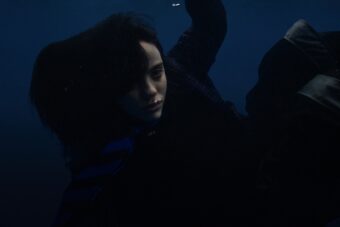Release Date: April 30, 2013
Label: Constellation
Patented in 1846, the bass saxophone was the first of Adolphe Sax’s most famous inventions, and the one closest in appearance to a steampunk fetish object. It looks archaic, oversized, even a little ludicrous, and sounds outright intimidating. Which made it an ideal metaphor for jazzy freedom in Czech writer Josef Skvorecky’s 1994 novella The Bass Saxophone, whose young protagonist’s first tentative honk evokes a “cruel, beautiful, infinitely sad sound” and a “muted desolation” reminiscent of “the way dying brachiosaurs wailed.” He goes on to compare its “nerve-shattering bellow” to the “voice of a melancholy gorilla” before concluding that “it frightened me.”
Begun in 2007, Colin Stetson’s three-volume New History Warfare scares me a little, too, not least of all because most of Skvorecky’s descriptors apply so readily to this trilogy’s circuitous squall and squeal. The first thing we hear in “And It Thought to Escape,” which begins Volume 1, is a breathy inhalation, the syncopated thuds of pancake pads striking brass tubing, and then a long trill that eventually breaks and cracks into harmonically layered wails to which Stetson adds his own voice in an unbroken polyphony of circular breathing. Over the course of his two subsequent volumes, Stetson expanded and developed this rudimentary grammar into something epic, with the help of dozens of microphones placed inside and outside his saxophone, strapped directly onto his throat, and deployed about his recording studios. On one important level, the result is an extended sonic meditation on the idea of interior versus exterior, or, as Stetson has characterized it, a sense of utter isolation amid the world at large.
A science-fiction and fantasy fan, he has also noted that the series began with his “obsession” about escaping from civilization in order to start anew on a boat sailing the seas. There’s nothing “free and easy” about Stetson’s dystopic 2008 take on the theme of Crosby, Stills, and Kantner’s 1969 tune “Wooden Ships,” however: The cover of Volume 1 depicts what appears to be an abandoned steamer, and Stetson’s sax often emits the mighty and majestic bellow of a fog- or ice-bound ocean liner. Even the usually optimistic Buckminster Fuller sounds bummed-out on samples of him musing on education and warfare. Volumes two (Judges) and three (To See More Light), Stetson says, represent the journey of a solitary soul isolated from his tribe, or species, with a parallel love story apparently emerging as well.
Stetson fully found his voice on 2011’s Judges, where he first employed a wide array of mics and took full command of his instrument, pulling out powerful deep notes he couldn’t quite hit earlier. Waking up on a beach, his hero spies a mass of crazed horses rigged with automatic cannons; the title track mimics their chaotic stampede with a 7/8 clatter of keys and Stetson’s most mournful wail. “What war is this?” asks guest vocalist Laurie Anderson. “What town could this be?” Stetson’s sound is densely multiphonic, often claustrophobic, and reeks of fear and flight. (Touring with Arcade Fire must be hairier than you imagine.)
But if Judges was apocalyptic in a Cormac McCarthy bad-road-trip kind of way, To See More Light offers at least a slight sense of salvation. More spacious than its predecessors, the concluding volume in this life-during-wartime saga begins with a multi-tracked and distorted Justin Vernon sounding no less abstract than his backing horn player. The pursuit continues in “Hunted,” with Stetson now emitting the cries of a wounded beast. The temporary sense of relief experienced in “High Above a Grey Green Sea” and the gorgeous “In Mirrors” evaporates in “Brute,” with Vernon adding a guttural black-metal scream to Stetson’s most brutally percussive playing. To See More Light was co-produced by Reykjavik-based Ben Frost, another purveyor and facilitator of post-industrial extremes of visceral oomph and argh.
Stetson’s perpetual-motion performances are best appreciated at length, and To See More Light‘s 15-minute title track is mesmerizingly mammoth. It has the feeling of a prayer, and segues smoothly into Vernon’s one-man-Beach Boys take on Washington Phillips’s late-’20s gospel standard “What Are They Doing in Heaven Today?” The elegiac theme continues in the trilogy’s concluding tracks: “This Bed of Shattered Bone,” with its spare tones, key clatters, and Vernon’s wordless wooing, suggests a rocky comedown from the heights of flight, while “Part of Me Apart from You” is incompleteness itself, with Stetson’s trademark arpeggios and mournful vocalizations fading to a slow, sad conclusion.
Although his extended sax techniques lie in the tradition of such jazz deities as Albert Ayler, Peter Brötzmann, Rahsaan Roland Kirk, Pharaoh Sanders, and Borbetomagus, improvisation takes a back seat to composition in Stetson’s playing. At nearly two-and-a-half hours — now that‘s a complete performance I look forward to hearing someday — the full New History Warfare bears a closer resemblance to Philip Glass’ own extended arpeggiation. Stetson also has a close contemporary in Diamond Terrifier, a.k.a tenor saxophonist Sam Hillmer of the trio ZS, whose late-May release The Subtle Body Wears a Shadow is the noetic, ghostly counterpart to Stetson’s rigorously brawny materialism. Hillmer makes his saxophone roar, crackle, and explode almost as furiously as Stetson’s does. But the linear breather extends his palette with electronics and other amplified objects, seeking self-realization through structured passion, hence Subtle Body‘s four eight-minute tracks. Stetson, who mixes things up with occasional clarinet, alto, and tenor solos, should join him someday for an exquisite yin/yang double bill.
Does New History Warfare justify three albums? Probably not — although hearing Stetson’s technique and vision expand along the way is gratifying in itself. Like most free jazz, it’s music of the moment, a work of granular epiphanies that accrete, finally, into a magnificent whole. It’s less successful as narrative, a failure Stetson says he’ll remedy down the line with a comic book. The dramatic peaks and valleys, the bleakness and transcendence he wants to convey are far from articulate, for better or worse. One thing’s for certain, though: Music this peerless at conveying isolation, loneliness, and alienation is sure to draw a sympathetic crowd.





